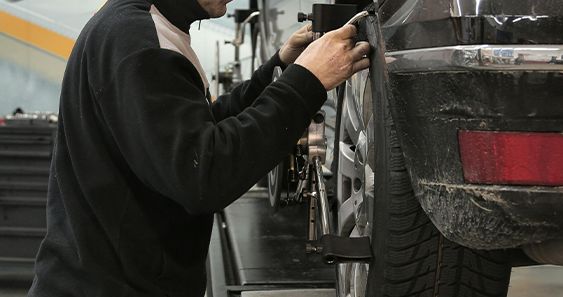Wheel alignment, or car alignment, is a very important process which affects the handling and performance of your vehicle. Read more to find out exactly what wheel alignment is, how it works, and why it’s important.
What is wheel alignment?
A wheel alignment is performed by a mechanic to ensure your car’s wheels are all mechanically calibrated to be pointing in the correct direction.
This may sound silly but your wheels can become misaligned very quickly by things such as collisions, repairs, even just general road use. Your mechanic will make adjustments to the vehicle’s suspension and axles to ensure correct alignment.
A common misconception is that only the front two wheels need to be properly aligned, as these are more important. This is not true though, to achieve a properly functioning vehicle, all wheels should be carefully aligned.
Why is wheel alignment important?
There are a number of reasons why wheel alignment is important, ranging from handling to safety reasons:
- Safety – Correct wheel alignment will improve the handling of your vehicle, leading to reduced risk of accidents.
- Convenience – Improved handling also makes the vehicle easier and more pleasurable to drive, on top of safety.
- Extend tire life – Misaligned wheels can cause increased wear on your tyres, as there will be more friction between the wheels and the road.
- Cost-effective – Not only will properly-aligned tyres decrease your chances of accidents, saving money, they will also increase fuel efficiency. This means you can drive further on each full tank, and with fuel prices these days, we all know that’s so valuable.
- Centered steering wheel – With misaligned wheels, you may have noticed that your steering wheel is not centered whilst you are driving completely straight. A successful wheel alignment should resolve this issue.
Effectively, correctly maintained wheel alignment is important both to keep yourself safe, and to save you money.

What happens during wheel alignment?
During a wheel alignment, we take a number of different steps to ensure a professional and accurate job:
- First, your mechanic will evaluate the condition of your vehicle. They will thoroughly analyse your tyres, suspension, steering wheel and many more aspects to check for any external damage or obvious flaws which will need to be amended upfront.
- Next, one of our professionals will use highly specialised equipment to measure the wheels in their current state. They will measure angles called ‘camber’ (inward or outward angling), ‘toe’ (the angle of the tyre relative to one another), ‘castor’ (the angle of the steering pivot as viewed from the side of the vehicle.
- The actual adjustment is of course the most important part of this process, your car will be hoisted up, attached to an alignment machine, then your mechanic will adjust alignment back to vehicle specifications. Each vehicle manufacturer has different specifications, and we’re careful to follow these specifications perfectly every time. The wheels will be adjusted based on the camber, toe, and castor angles.
- After this step, your mechanic will ensure that your steering wheel is also centred. Your wheels may be perfectly aligned, but if your steering is off-center, you probably won’t feel the benefits of this at all.
- After this, a test drive is usually performed in a controlled manner to ensure that we haven’t run into any unexpected problems and that the vehicle is safe (and easy) to drive. Hopefully, all issues have now been resolved and you can get back on the road!
What will happen if I don’t get my wheels aligned?
If you don’t get your wheels aligned, you could run into a number of problems. You may experience poor handling, reduced grip on the road as manual problems. Otherwise, your car will need to use more fuel to overcompensate for misalignment, and your tires will become worn quicker.
Nine times out of ten, you probably won’t run into any safety issues through wheel misalignment, but there will always be some increased risk. We would always recommend getting your wheels aligned at least once a year, or after any incident or accidents on the road.
As mentioned, it’s unlikely you’ll experience an incident caused by poorly aligned wheels, but not impossible and, surely, it’s not worth the risk.

